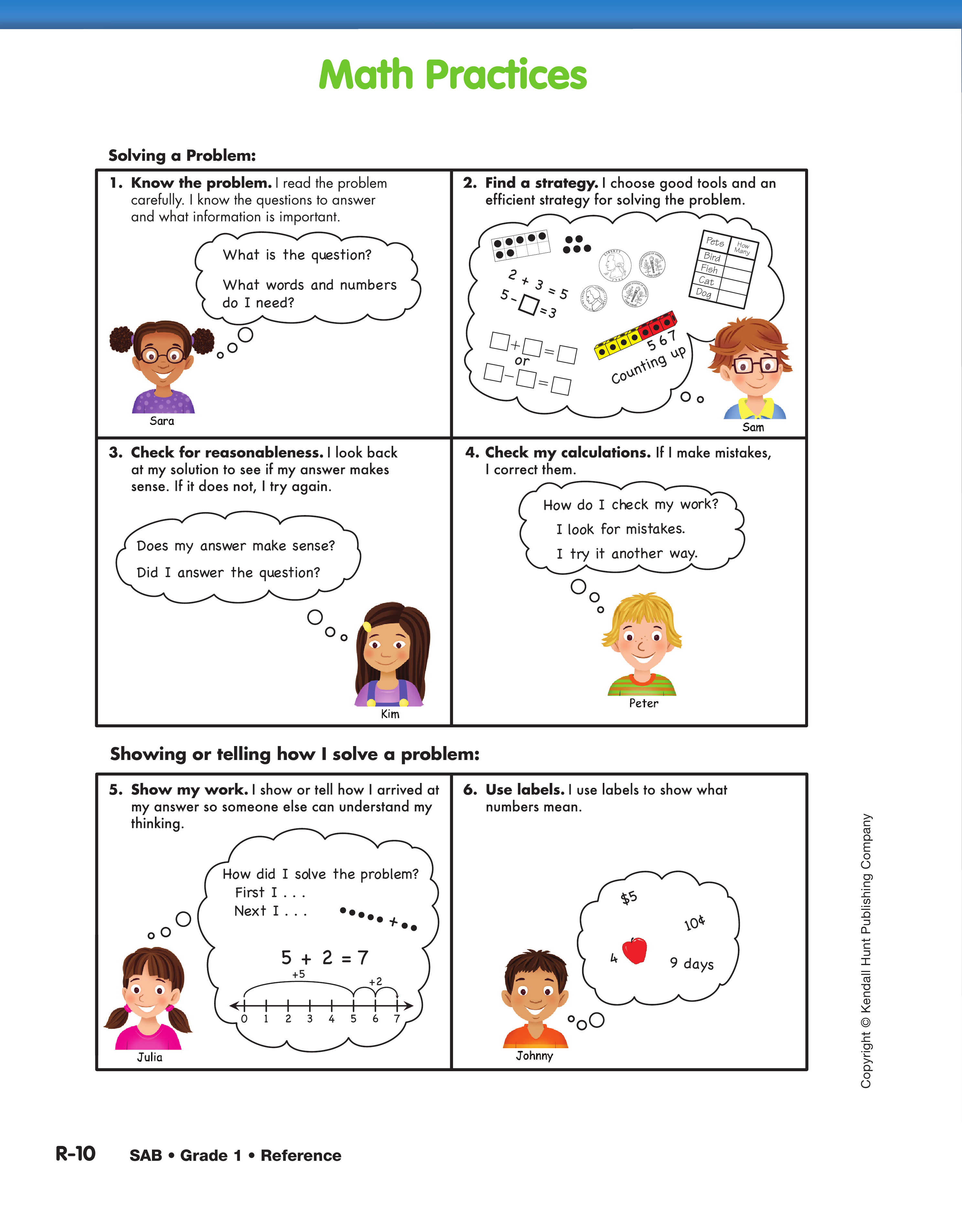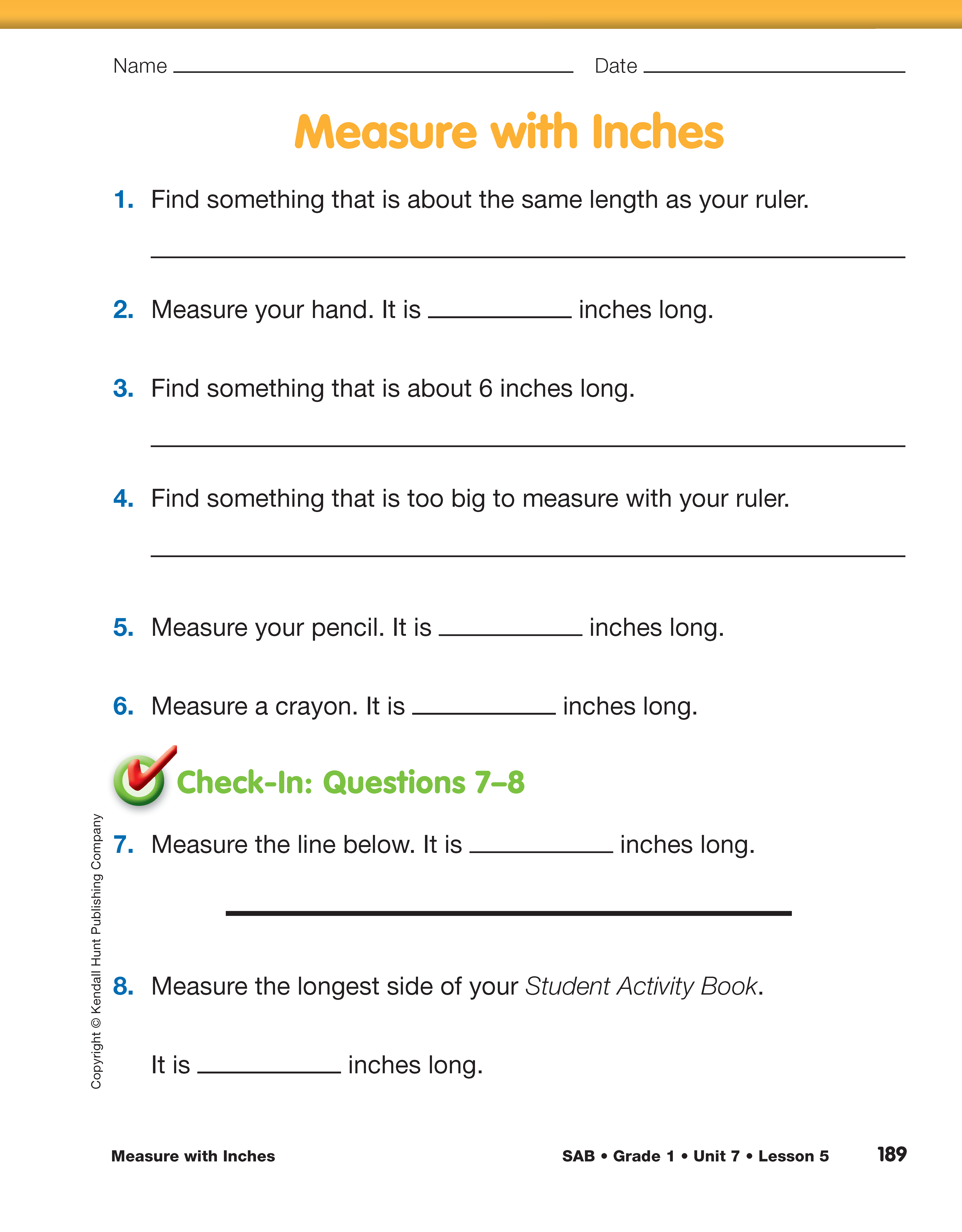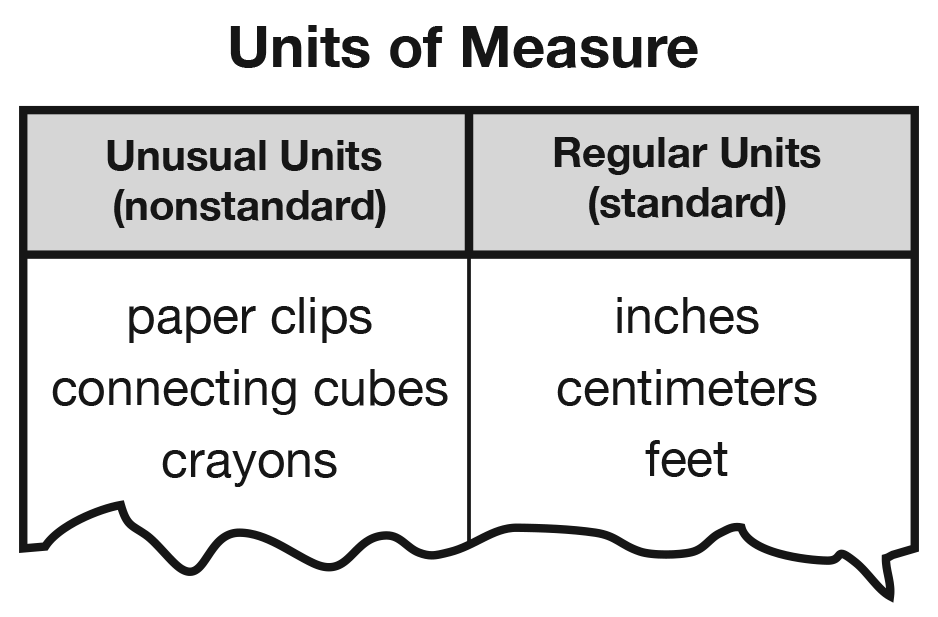Explore the Need for Standard Units. Introduce
the lesson by reviewing Rolf Myller's story, How
Big Is a Foot? from Lesson 4.
- What did the king want to have built? (a bed for the queen)
- How did he measure the queen? (with his feet)
- What did the young carpenter's apprentice use as
a measure for the bed? (He measured the bed
with his own small feet.)
- Why was that a problem? (The apprentice's feet
were not the same size as the king's feet. They
were much smaller.)
- How did the first bed turn out? (It was too small
for the queen.)
- How did the king and the apprentice solve the
problem? (They made a marble copy of the
king's foot to use as a standard or regular measure
in the kingdom.)
- Are the king's and the apprentice's feet unusual
units of measure? Why or why not? (Yes;
Everyone has different-size feet.)
- Why don't we regularly measure things with our
feet? (Our feet are different sizes.)
- Why was it important to have a marble copy of the
king's foot to use for measuring lengths in the
kingdom? (The marble copy is always the same
size and everyone will know its size. Accurate
measurements can be made with the marble
copy.)
- What if you said, "My desk is 10 hands long"?
Would someone else know the length of your
desk? Explain. (Possible response: Probably not;
They do not know how big the hands are. Are
they a child's or an adult's hands? Were they
clenched in a fist or
spread out?)
- Why is it hard to use nonstandard or unusual units
with people who might not understand them? (The
nonstandard units may or may not be available,
so someone else might not understand how big
they are.)
Guide students to see the inherent difficulties in
using nonstandard units such as links, paper clips,
and crayons. Explain to students that long ago, people
had the same problems the king and the apprentice
did. So they agreed on certain units that are
regular and the same everywhere. See the Sample
Dialog for a continued discussion of the advantages
and disadvantages of different units of measure.
- The apprentice in the story had to measure length
when he built a bed. What are some things that
involve measuring length? (Possible responses:
building houses, roads, bridges, furniture, making
clothes)
- What had to be measured when the things in this
classroom were built? (Possible responses: the
lengths of the doors and windows when fitting
them into the walls; the table legs so they were
all the same size; the floor when tiling)
- Imagine what would have happened if all the
builders and workers who built these things had
used different units.
Display the Units of Measure chart you prepared
prior to the lesson and ask students to brainstorm a
list of units used to measure length. See Figure 2. As
students share their responses, list them on the chart.
- We have used a lot of unusual units of measure.
What are some of the things we have used to measure
lengths? (Possible responses: links, connecting
cubes, pencils, paper clips, foot lengths)
- What are some other units people use when measuring
length? (Possible responses: inches, feet,
yards, meters, centimeters)
Introduce the Inch. This discussion introduces a
standard unit of measure, the inch.
- What do you know about inches? (Responses will
vary. Some students may show on their finger
how big they think an inch is, or suggest that
they are found on rulers.)
Display and distribute a 12-inch ruler to students or
student pairs. Show students one inch on the display
ruler. Tell them that this is the standard unit, the
inch, and it has been agreed upon everywhere to be
this size. Show students that there are 12 inches on
the ruler. Point to each inch mark and have students
count from 1–12 aloud.
Compare the ruler to a number line and ask:
- Where would zero inches be on the ruler?
- Where should we start to measure on the ruler? (at the zero end)
Some students may volunteer standard units that are used
for quantities other than length, such as pounds or gallons. It
is sufficient for now that the answer be validated as a
standard unit and included on the board. However, the
students should be informed that these units do not measure
length but measure something else, weight and volume.
Therefore, they will not be used in this lesson, but students
will encounter them in later units and grades.
Measure with a Ruler and Use Labels. Remind
students of good measurement practice by reviewing
the Measuring Advice chart from Lesson 2.
Demonstrate measuring a pencil using the ruler on
display.
- How does a ruler help us follow the good measurement
advice? (It's in a straight line; there are no
gaps between the inches; all the inches are the
same length.)
- What do we still need to remember when we measure
with a ruler? (Start at the end at zero; go only
as far as the pencil goes; figure out what to do
with the extra parts, e.g., ½ inch.)
Add these pieces of advice to the list on the chart:
- Always line up the edge of the object with zero
on the ruler.
- Use words like "between," "close to," and "a little
more than" when measurement is in between
whole inches.
Display the Math Practices page from the Student
Activity Book Reference section. Direct students'
attention to Math Practices Expectation 6, Use
labels. Tell students that it is important to report
their measurements with both numbers and units, in
this case inches. This enables others to understand
our measurements clearly.
Ask students to suggest other objects to be measured
such as an eraser, a stapler, and a tissue box. You
may choose to measure some of the items they measured
with links in Lesson 2. Demonstrate the correct
measuring techniques on some of the objects
and have student volunteers demonstrate measuring
the others. Remind them to clearly state the unit of
measure, inches. When they measure objects that are
not a whole number of inches long, encourage them
to practice describing number relationships by saying
"between 6 and 7 inches," "close to 7 inches," or
a "little less than 7 inches."
- Can you find something in our classroom that is a
little longer than 12 inches? Let's measure it to
find out.
- Can you find something in our classroom that is a
little shorter than 12 inches? Let's measure it to
find out.

This is a discussion of the advantages and disadvantages of
different units of measure.
Teacher: How could you measure the length of your desk top
here at school so that your cousin could make a cover
that is the right length? Ming?
Ming: I would use my hands to measure.
Teacher: Let's say you measure your desk with your hands
closed and flat like this [showing her hand with fingers
together and holding it flat] and that your desk is ten
hands. How will someone at home measure to make
sure it is the same?
Ming: With her hands.
Teacher: Will she get the same measure with her
hands?
Ming: Ummm… Maybe not.
Teacher: What else could you measure with? Irma?
Irma: I have mittens, and she could use my mittens and I
could use my hands.
Teacher: Okay, so then you would both be using the same
size with hands and mittens. That might work. Are your
mittens just as long as your hands?
Irma: My mittens are good. They have padding to keep my
hands warm.
Teacher: Maybe your mittens are longer than your hands so
that your hands can fit in them easily. Could they be
longer than your hands, Irma?
Irma: Yes, maybe they are because my fingers fit in them.
Teacher: Does someone else have a different idea about
what you could use to measure?
Frank: I just used connecting cubes and I could just tell her to
use connecting cubes. But maybe she doesn't have any
connecting cubes, so I guess it wouldn't work.
Ana: Can't we just use a ruler?
Teacher: Why would you use a ruler?
Ana: Because that's what my mother uses and also my
brother. He uses a ruler a lot for school.
Teacher: Rulers do have some advantages.
Estimate Lengths. Have students put their rulers away.
Ask questions that will require students to use estimation skills:
- Name something that is a lot longer than 12 inches.
- Name something that is a lot shorter than 12 inches.
- Is a piece of toast longer or shorter than 12 inches? (shorter than 12 inches)
- Is your foot longer or shorter than 12 inches? (shorter than 12 inches)
- Is the length of my desk longer or shorter than
12 inches? (longer than 12 inches)
Have student pairs complete the Measure with
Inches page in the Student Activity Book with a 12-inch ruler. They will measure objects in the classroom.
Remind students to begin at zero on their
rulers. Circulate among students to check their measuring
techniques.

Use Check-In: Questions 7–8 on the Measure with Inches
page in the Student Activity Book to assess students' abilities
to measure in inches [E9] and to use labels to indentify units
of measure [MPE6].
To provide targeted practice with measuring in inches, place
12-inch rulers and an assortment of objects in a center for
students to measure with standard units, similar to activities
in DPP item W Find an Object: Inches, item X Find Two
Objects: Inches, and item Y Measure with Two Units. Ask
students to measure the objects' lengths. Also ask students
to find objects that are about 6 inches long, 12 inches long,
24 inches long, and so on. Alternatively, ask students to
measure the same object using both nonstandard units, such
as links, and inches and to compare the measurements.


















